check engine light Acura TL 2000 3.2 User Guide
[x] Cancel search | Manufacturer: ACURA, Model Year: 2000, Model line: TL, Model: Acura TL 2000Pages: 311, PDF Size: 3.05 MB
Page 215 of 311
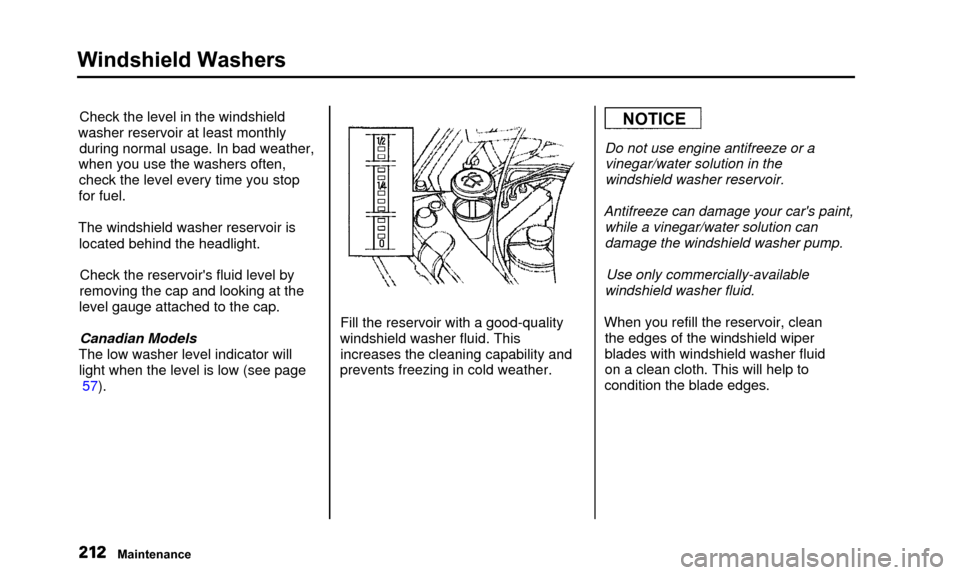
Windshield Washers
Check the level in the windshield
washer reservoir at least monthly during normal usage. In bad weather,
when you use the washers often, check the level every time you stop
for fuel.
The windshield washer reservoir is located behind the headlight.
Check the reservoir's fluid level by
removing the cap and looking at the
level gauge attached to the cap.
Canadian Models
The low washer level indicator will light when the level is low (see page 57). Fill the reservoir with a good-quality
windshield washer fluid. This increases the cleaning capability and
prevents freezing in cold weather.NOTICE
Do not use engine antifreeze or a vinegar/water solution in the
windshield washer reservoir.
Antifreeze can damage your car's paint, while a vinegar/water solution can
damage the windshield washer pump.
Use only commercially-available
windshield washer fluid.
When you refill the reservoir, clean the edges of the windshield wiper
blades with windshield washer fluid
on a clean cloth. This will help to
condition the blade edges.
Maintenance
Page 228 of 311
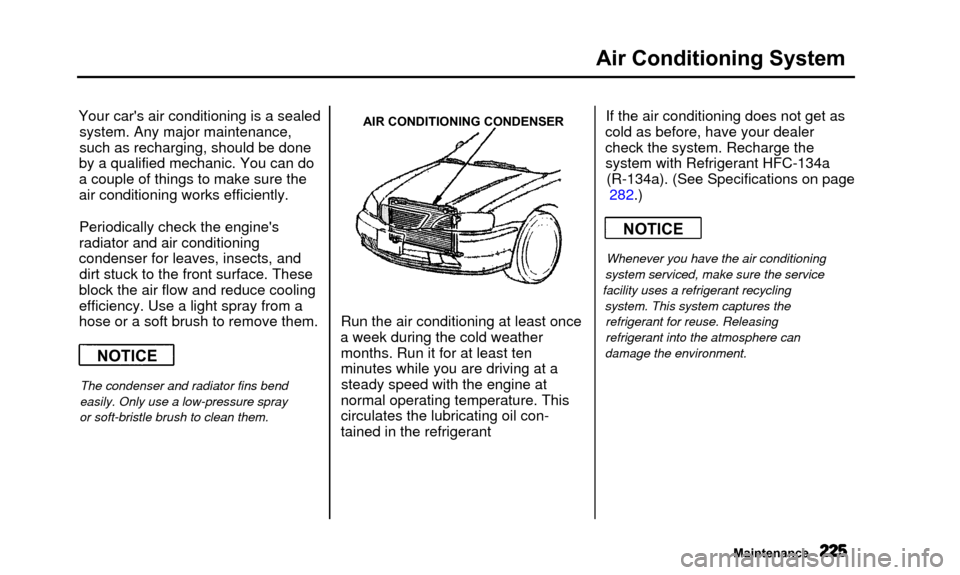
Air Conditioning System
Your car's air conditioning is a sealedsystem. Any major maintenance,
such as recharging, should be done
by a qualified mechanic. You can do
a couple of things to make sure the
air conditioning works efficiently.
Periodically check the engine's
radiator and air conditioning
condenser for leaves, insects, and dirt stuck to the front surface. These
block the air flow and reduce cooling
efficiency. Use a light spray from a
hose or a soft brush to remove them.
The condenser and radiator fins bend
easily. Only use a low-pressure spray
or soft-bristle brush to clean them. AIR CONDITIONING CONDENSER
Run the air conditioning at least once
a week during the cold weather months. Run it for at least ten
minutes while you are driving at asteady speed with the engine at
normal operating temperature. This
circulates the lubricating oil con-
tained in the refrigerant If the air conditioning does not get as
cold as before, have your dealer
check the system. Recharge the system with Refrigerant HFC-134a (R-134a). (See Specifications on page 282.)
Whenever you have the air conditioning
system serviced, make sure the service
facility uses a refrigerant recycling system. This system captures therefrigerant for reuse. Releasing
refrigerant into the atmosphere can
damage the environment.
Maintenance
NOTICE
NOTICE
Page 264 of 311

If Your Engine Won't Start
Nothing Happens or the Starter
Motor Operates Very Slowly
When you turn the ignition switch to START (III), you do not hear the
normal noise of the engine trying tostart. You may hear a clicking sound
or series of clicks, or nothing at all.
Check these things:• Check the transmission interlock. The transmission must be in Parkor Neutral or the starter will not
operate.
• Turn the ignition switch to ON (II).
Turn on the headlights and check their brightness. If the headlightsare very dim or don't light at all,
the battery is discharged. See
Jump Starting on page 262.
• Turn the ignition switch to START (III). If the headlights do not dim,
check the condition of the fuses. If
the fuses are OK, there is proba-
bly something wrong with the electrical circuit for the ignitionswitch or starter motor. You will
need a qualified technician to determine the problem. (See
Emergency Towing on page 277.)
If the headlights dim noticeably or
go out when you try to start the engine, either the battery is dis-
charged or the connections are
corroded. Check the condition of
the battery and terminal connec- tions (see page 220). You can
then try jump starting the car froma booster battery (see page 262).
Taking Care of the Unexpected
Page 265 of 311

If Your Engine Won't Start, Jump Starting
The Starter Operates NormallyIn this case, the starter motor's
speed sounds normal, or even faster
than normal, when you turn the
ignition switch to START (III), but
the engine does not run.
• Your car has the Immobilizer System. You should use a
properly-coded master or valet key
to start the engine (see page 74).
A key that is not properly coded will cause the immobilizer systemindicator in the dash panel to blink
rapidly.
• Are you using the proper starting procedure? Refer to Starting theEngine on page 161.
• Do you have fuel? Turn the
ignition switch to ON (II) for a
minute and watch the fuel gauge.
The low fuel level warning light may not be working, so you were
not reminded to fill the tank.
• There may be an electrical problem, such as no power to the
fuel pump. Check all the fuses (see page 273).
If you find nothing wrong, you will
need a qualified technician to find
the problem. See Emergency
Towing on page 277. Jump Starting
If your car's battery has run down,
you may be able to start the engine by using a booster battery. Although
this seems like a simple procedure,
you should take several precautions.
A battery can explode if you donot follow the correct procedure,
seriously injuring anyone nearby.
Keep all sparks, open flames,
and smoking materials away
from the battery.
You cannot start your Acura by pushing or pulling it.
Taking Care of the Unexpected
Page 266 of 311

Jump Starting
To jump start your car, follow thesedirections closely:
1. Open the hood and check the physical condition of the battery(see page 220). In very cold
weather, check the condition of
the electrolyte. If it seems slushy or like ice, do not try jump starting
until it thaws.
NOTICE
If a battery sits in extreme cold, the
electrolyte inside can freeze.
Attempting to jump start with a frozen battery can cause it to rupture.
2. Turn off all the electrical acces- sories: climate control, stereo
system, lights, etc.
Put the transmission in Neutral or
Park and set the parking brake. 3. Remove the battery cover.
4. Connect one jumper cable to the positive (+) terminal on the
booster battery. Connect the otherend to the positive (+) terminal
on your Acura's battery. 5. Connect the second jumper cable
to the negative (—) terminal on
the booster battery. Connect theother end to the grounding strap
as shown. Do not connect this
jumper cable to any other part of the engine.
CONTINUED
Taking Care of the Unexpected
Page 270 of 311
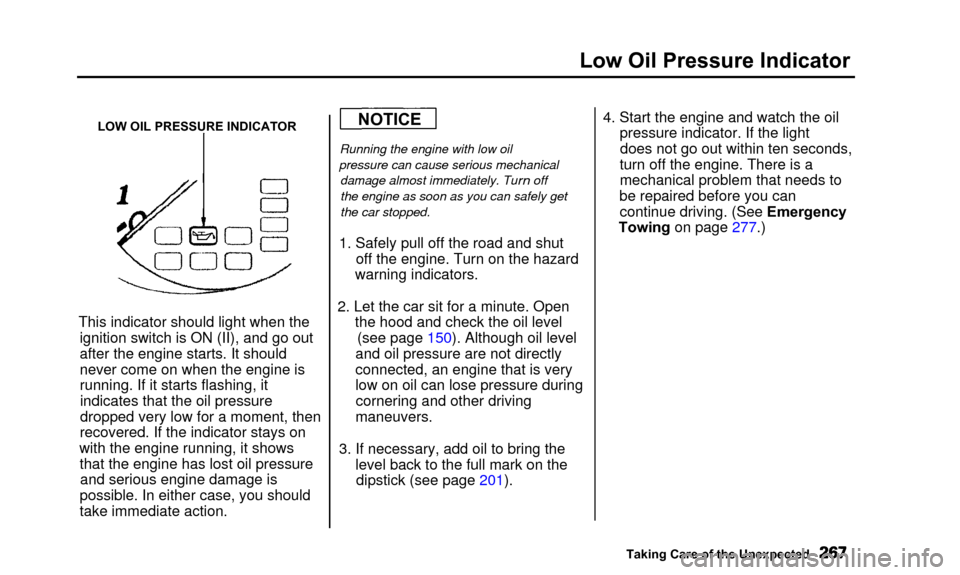
Low Oil Pressure Indicator
LOW OIL PRESSURE INDICATOR
This indicator should light when theignition switch is ON (II), and go out
after the engine starts. It should
never come on when the engine is
running. If it starts flashing, itindicates that the oil pressure
dropped very low for a moment, then
recovered. If the indicator stays on
with the engine running, it shows that the engine has lost oil pressureand serious engine damage is
possible. In either case, you should
take immediate action.
Running the engine with low oil
pressure can cause serious mechanical damage almost immediately. Tu
rn off
the engine as soon as you can safely get
the car stopped.
1. Safely pull off the road and shut off the engine. Turn on the hazard
warning indicators.
2. Let the car sit for a minute. Open the hood and check the oil level(see page 150). Although oil level
and oil pressure are not directly
connected, an engine that is very
low on oil can lose pressure during cornering and other driving
maneuvers.
3. If necessary, add oil to bring the level back to the full mark on thedipstick (see page 201). 4. Start the engine and watch the oil
pressure indicator. If the lightdoes not go out within ten seconds,
turn off the engine. There is a
mechanical problem that needs to
be repaired before you can continue driving. (See Emergency
Towing on page 277.)
Taking Care of the Unexpected
NOTICE
Page 273 of 311

Brake System Indicator
BRAKE SYSTEM INDICATOR
The Brake System Indicator lightcomes on when you turn the ignitionON (II). If the parking brake is not
set, it goes off after you start the
engine. If the parking brake is set, it
goes off when you fully release the parking brake with the engine
running. If it comes on at any other time, it
indicates a problem with the car's
brake system. In most cases, the problem is a low fluid level in the
brake fluid reservoir. Press lightly on
the brake pedal to see if it feels normal. If it does, check the brake
fluid level the next time you stop at a service station (see page 214). If the
fluid level is low, take the car to your dealer and have the brake system
inspected for leaks or worn brake
pads.
However, if the brake pedal does not
feel normal, you should take immediate action. Because of the
brake system's dual-circuit design, a
problem in one part of the system will still give you braking at two
wheels. You will feel the brake pedal
go down much farther before the car
begins to slow down, and you will
have to press harder on the pedal.
The distance needed to stop will be much longer. Slow down by shifting to a lower
gear, and pull to the side of the road
when it is safe. Because of the longer distance needed to stop, it is
hazardous to drive the car. Youshould have it towed, and repaired as
soon as possible. (See Emergency
Towing on page 277.)
If you must drive the car a shortdistance in this condition, driveslowly and cautiously.
Taking Care of the Unexpected
Page 302 of 311
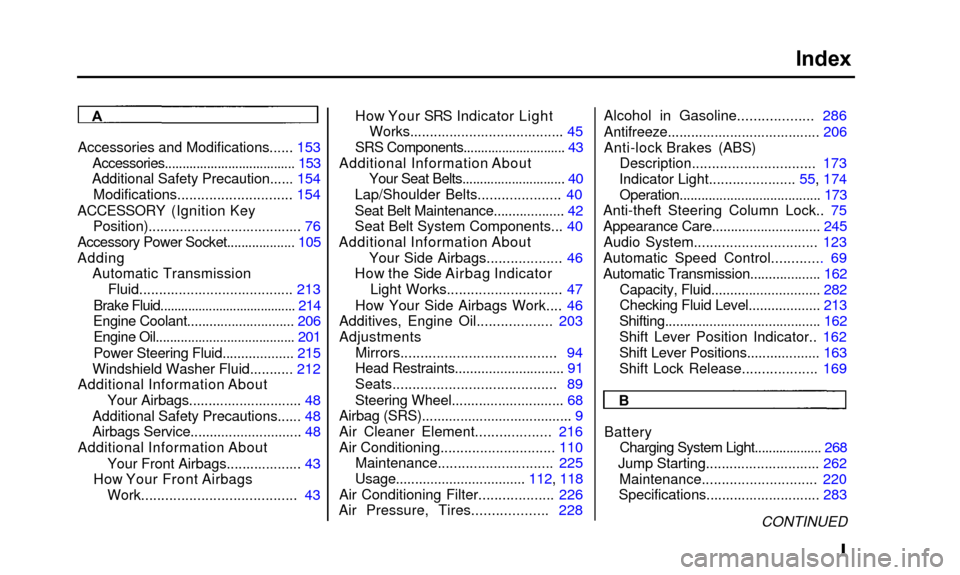
Index
Accessories and Modifications...... 153
Accessories..................................... 153
Additional Safety Precaution...... 154
Modifications............................. 154
ACCESSORY (Ignition Key Position)........ .............................. . 76
Accessory Power Socket......... .......... 105
Adding Automatic Transmission Fluid......... .............................. 213
Brake Fluid......... .............................. 214
Engine Coolant......... .................... 206
Engine Oil....................................... 201
Power Steering Fluid................... 215
Windshield Washer Fluid......... .. 212
Additional Information About Your Airbags........ ..................... 48
Additional Safety Precautions...... 48
Airbags Service........ ..................... 48
Additional Information About
Your Front Airbags................... 43
How Your Front Airbags Work........ .............................. . 43How Your SRS Indicator Light
Works....................................... 45
SRS Components............................. 43
Additional Information About Your Seat Belts........ ..................... 40
Lap/Shoulder Belts..................... 40
Seat Belt Maintenance................... 42
Seat Belt System Components... 40
Additional Information About Your Side Airbags................... 46
How the Side Airbag Indicator Light Works............................. 47
How Your Side Airbags Work.... 46
Additives, Engine Oil................... 203
Adjustments Mirrors....................................... 94
Head Restraints........ ..................... 91
Seats........................................ . 89
Steering Wheel............................ . 68
Airbag (SRS)....................................... 9
Air Cleaner Element................... 216
Air Conditioning............................. 110
Maintenance......... .................... 225
Usage................................. . 112, 118
Air Conditioning Filter......... .......... 226
Air Pressure, Tires......... .......... 228Alcohol in Gasoline................... 286
Antifreeze.........
.............................. 206
Anti-lock Brakes (ABS) Description......... ...................... 173
Indicator Light......... ............. 55, 174
Operation....................................... 173
Anti-theft Steering Column Lock.. 75
Appearance Care............................. 245 Audio System............................... 123
Automatic Speed Control........ ..... 69
Automatic Transmission......... .......... 162
Capacity, Fluid............................. 282
Checking Fluid Level................... 213
Shifting.......................................... 162
Shift Lever Position Indicator.. 162
Shift Lever Positions................... 163
Shift Lock Release......... .......... 169
A
B
Battery Charging System Light................... 268
Jump Starting......... .................... 262
Maintenance............................. 220
Specifications......... .................... 283
CONTINUED
Page 303 of 311
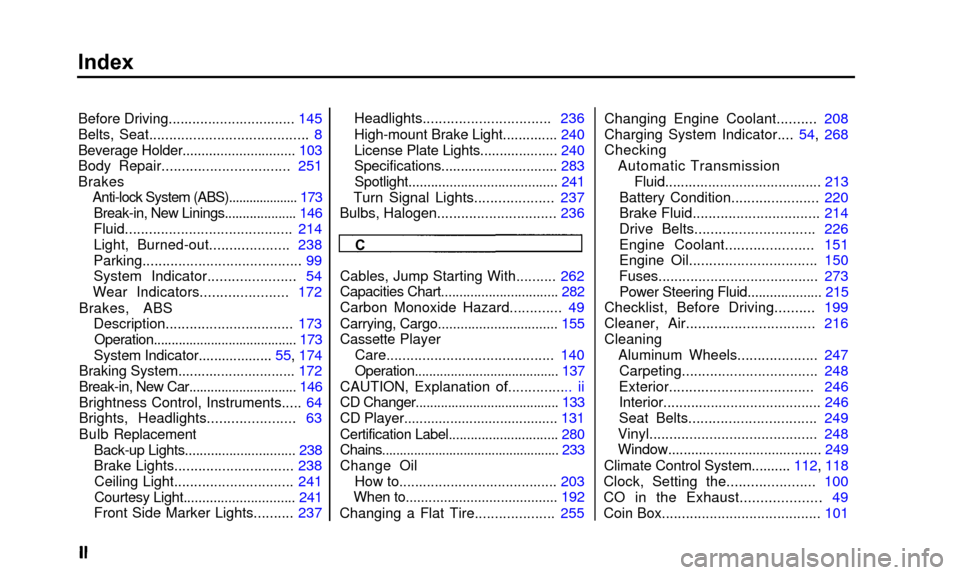
Index
Before Driving................................ 145
Belts, Seat........................................ 8
Beverage Holder.......... .................... 103
Body Repair.......... ...................... 251
Anti-lock System (ABS).......... .......... 173
Break-in, New Linings.......... .......... 146
Fluid.......................................... 214
Light, Burned-out.......... .......... 238
Parking........................................ 99
System Indicator...................... 54
Wear Indicators.......... ............ 172
Brakes, ABS Description................................ 173Operation........................................ 173
System Indicator....... ............ 55, 174
Braking System.............................. 172
Break-in, New Car.......... .................... 146
Brightness Control, Instruments... .. 64
Brights, Headlights...................... 63
Bulb Replacement Back-up Lights.............................. 238
Brake Lights.............................. 238Ceiling Light.............................. 241
Courtesy Light.......... .................... 241
Front Side Marker Lights.......... 237 Headlights..........
...................... 236
High-mount Brake Light.......... .... 240
License Plate Lights.......... .......... 240
Specifications.............................. 283
Spotlight........................................ 241
Turn Signal Lights.................... 237
Bulbs, Halogen.......... .................... 236Changing Engine Coolant.......... 208
Charging System Indicator.... 54, 268
Checking
Automatic Transmission Fluid........................................ 213
Battery Condition...................... 220
Brake Fluid................................ 214
Drive Belts.......... .................... 226
Engine Coolant.......... ............ 151
Engine Oil................................ 150
Fuses........................................ 273 Power Steering Fluid.......... .......... 215
Checklist, Before Driving.......... 199
Cleaner, Air................................ 216
Cleaning
Aluminum Wheels.......... .......... 247
Carpeting.................................. 248
Exterior.......... .......................... 246
Interior.......... .............................. 246
Seat Belts................................ 249
Vinyl.......................................... 248
Window........................................ 249
Climate Control System.......... 112, 118
Clock, Setting the...................... 100
CO in the Exhaust......... ........... 49
Coin Box........................................ 101
C
Cables, Jump Starting With .......... 262
Capacities Chart................................ 282
Carbon Monoxide Hazard............. 49
Carrying, Cargo ................................ 155
Cassette Player Care.......................................... 140
Operation........................................ 137
CAUTION, Explanation of................ ii
CD Changer........................................ 133
CD Player........................................ 131
Certification Label.............................. 280
Chains.................................................. 233
Change Oil How to........................................ 203
When to........................................ 192
Changing a Flat Tire.................... 255
Brakes
Page 304 of 311
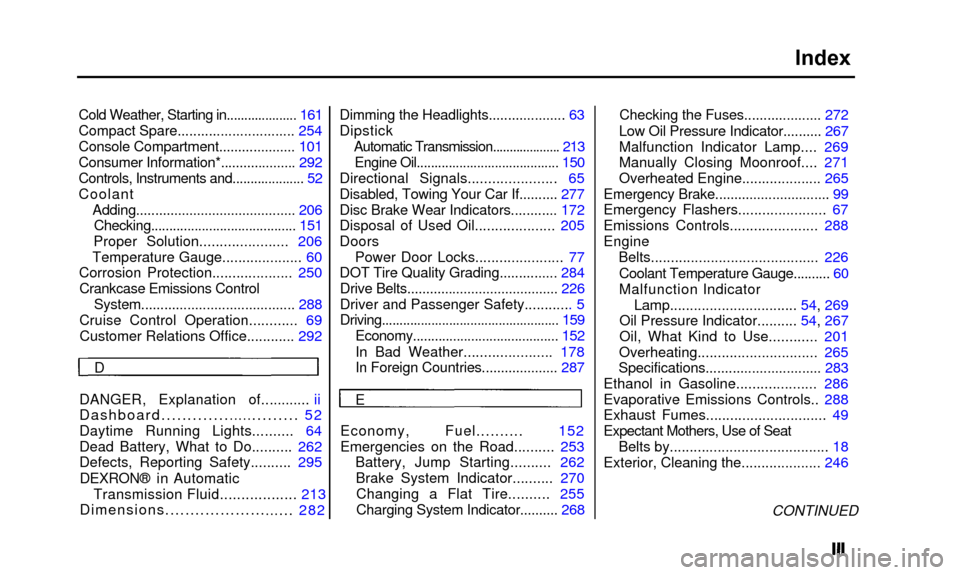
Index
Cold Weather, Starting in.................... 161
Compact Spare.............................. 254
Console Compartment.......... .......... 101
Consumer Information*.......... .......... 292
Controls, Instruments and.................... 52
Coolant
Adding.......................................... 206 Checking........................................ 151
Proper Solution...................... 206
Temperature Gauge.................... 60
Corrosion Protection.......... .......... 250
Crankcase Emissions Control System........................................ 288
Cruise Control Operation.......... .. 69
Customer Relations Office............ 292 Dimming the Headlights.........
........... 63
Dipstick Automatic Transmission.......... .......... 213
Engine Oil.......... .............................. 150
Directional Signals......... ............. 65
Disabled, Towing Your Car If.......... 277
Disc Brake Wear Indicators............ 172
Disposal of Used Oil.......... .......... 205
Doors Power Door Locks......... ............. 77
DOT Tire Quality Grading.......... ..... 284
Drive Belts.......... .............................. 226
Driver and Passenger Safety............ 5
Driving.................................................. 159
Economy........................................ 152
In Bad Weather.......... ............ 178
In Foreign Countries.................... 287 Checking the Fuses.................... 272
Low Oil Pressure Indicator.......... 267
Malfunction Indicator Lamp.... 269
Manually Closing Moonroof.... 271
Overheated Engine..........
.......... 265
Emergency Brake.............................. 99
Emergency Flashers...................... 67
Emissions Controls...................... 288
Engine Belts.......................................... 226
Coolant Temperature Gauge.......... 60
Malfunction IndicatorLamp................................ 54, 269
Oil Pressure Indicator.......... 54, 267
Oil, What Kind to Use.......... .. 201
Overheating.............................. 265
Specifications.......... .................... 283
Ethanol in Gasoline.................... 286
Evaporative Emissions Controls.. 288
Exhaust Fumes......... ..................... 49
Expectant Mothers, Use of Seat Belts by........................................ 18
Exterior, Cleaning the.......... .......... 246
CONTINUED
D
DANGER, Explanation of...
......... ii
Dashboard.............
.............. 52
Daytime Running Lights.......... 64
Dead Battery, What to Do.......... 262
Defects, Reporting Safety.......... 295
DEXRON® in Automatic Transmission Fluid.................. 213
Dimensions....................
...... 282 E
Economy, Fuel.......... 152
Emergencies on the Road.......... 253 Battery, Jump Starting.......... 262Brake System Indicator.......... 270Changing a Flat Tire.......... 255Charging System Indicator.......... 268